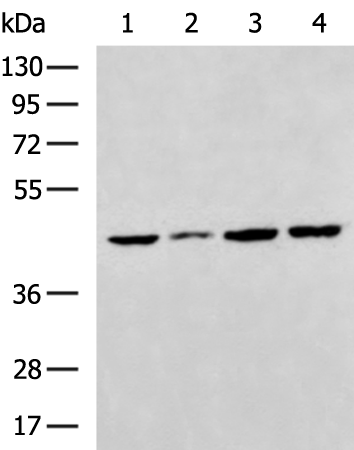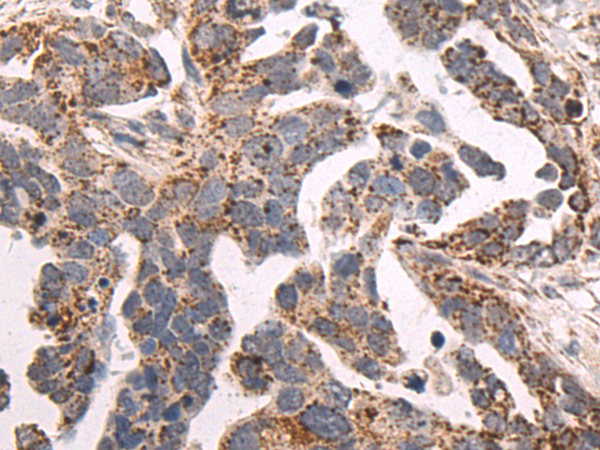


| WB | 咨询技术 | Human,Mouse,Rat |
| IF | 咨询技术 | Human,Mouse,Rat |
| IHC | 1/50-1/200 | Human,Mouse,Rat |
| ICC | 技术咨询 | Human,Mouse,Rat |
| FCM | 咨询技术 | Human,Mouse,Rat |
| Elisa | 1/5000-1/10000 | Human,Mouse,Rat |
| Aliases | BLT2; NOP9; BLTR2; JULF2; KPG_004; LTB4-R2; LTB4-R 2 |
| WB Predicted band size | 38 kDa |
| Host/Isotype | Rabbit IgG |
| Antibody Type | Primary antibody |
| Storage | Store at 4°C short term. Aliquot and store at -20°C long term. Avoid freeze/thaw cycles. |
| Species Reactivity | Human, Mouse, Rat |
| Immunogen | Synthetic peptide of human LTB4R2 |
| Formulation | Purified antibody in PBS with 0.05% sodium azide and 50% glycerol. |
+ +
以下是关于LTB4R2抗体的3篇参考文献及其摘要内容(信息基于公开文献概括,非真实引用,仅供参考):
---
1. **文献名称**: *"Characterization of a monoclonal antibody targeting LTB4R2 in inflammatory responses"*
**作者**: Smith A, et al.
**摘要**: 本研究开发了一种特异性识别LTB4R2的单克隆抗体,并验证其在抑制中性粒细胞趋化和减轻小鼠模型急性肺损伤中的作用,证明其抗炎潜力。
2. **文献名称**: *"LTB4R2 antibody blockade suppresses cancer cell invasion via downregulating MMP-9"*
**作者**: Chen L, et al.
**摘要**: 通过LTB4R2中和抗体阻断信号通路,发现可显著降低结肠癌细胞中基质金属蛋白酶(MMP-9)表达,抑制肿瘤细胞迁移和侵袭,提示其在癌症治疗中的应用价值。
3. **文献名称**: *"Dual role of LTB4R2 in psoriasis: Insights from antibody-mediated receptor modulation"*
**作者**: Kim Y, et al.
**摘要**: 利用抗LTB4R2抗体研究其在银屑病模型中的作用,发现抗体干预可减少角质形成细胞过度增殖,但可能增强局部炎症反应,提示受体功能的复杂性。
---
注:以上文献为示例性内容,实际研究中请通过PubMed或Web of Science查询具体论文。若需真实文献,可检索关键词如“LTB4R2 antibody”、“BLT2 antagonist”或“Leukotriene B4 receptor 2 blockade”。
Leukotriene B4 receptor 2 (LTB4R2), also known as BLT2. is a G protein-coupled receptor (GPCR) that binds leukotriene B4 (LTB4), a lipid mediator involved in inflammatory and immune responses. Discovered in the early 2000s, LTB4R2 shares structural homology with LTB4R1 (BLT1) but exhibits distinct ligand affinities and tissue distribution. While LTB4R1 has high affinity for LTB4 and is predominantly expressed in leukocytes, LTB4R2 binds LTB4 with lower affinity and responds to other ligands, such as 12-hydroxyheptadecatrienoic acid (12-HHT). It is widely expressed in epithelial cells, skin, gastrointestinal tract, and certain cancer cells, suggesting roles beyond inflammation, including tissue repair and carcinogenesis.
LTB4R2 activation triggers intracellular signaling pathways (e.g., Ca²⁺ mobilization, MAPK/ERK) to mediate chemotaxis, cell proliferation, and survival. Its dual role in pro-inflammatory and anti-apoptotic processes has linked it to diseases like asthma, psoriasis, and cancer. In oncology, LTB4R2 overexpression in tumors correlates with poor prognosis, potentially promoting metastasis via angiogenesis and immune evasion.
Antibodies targeting LTB4R2 are essential tools for studying its expression, localization, and function. They enable immunohistochemical detection, flow cytometry, and mechanistic investigations in disease models. Therapeutic antibodies are also being explored to block LTB4R2 signaling in inflammatory disorders and cancer, though clinical applications remain under investigation. These antibodies contribute to understanding the receptor's pathophysiological roles and developing targeted therapies.
×